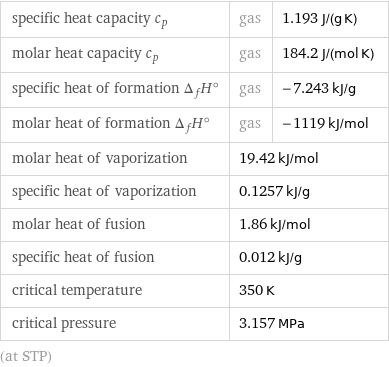Input interpretation

chloropentafluoroethane
Chemical names and formulas

formula | C_2ClF_5 name | chloropentafluoroethane IUPAC name | 1-chloro-1, 1, 2, 2, 2-pentafluoro-ethane alternate names | 1-chloro-1, 1, 2, 2, 2-pentafluoroethane | CFC-115 | chloroperfluoroethane | ethane, chloropentafluoro- | Freon 115 | pentafluorochloroethane | R-115 mass fractions | C (carbon) 15.6% | Cl (chlorine) 23% | F (fluorine) 61.5%
Lewis structure

Draw the Lewis structure of chloropentafluoroethane. Start by drawing the overall structure of the molecule: Count the total valence electrons of the carbon (n_C, val = 4), chlorine (n_Cl, val = 7), and fluorine (n_F, val = 7) atoms: 2 n_C, val + n_Cl, val + 5 n_F, val = 50 Calculate the number of electrons needed to completely fill the valence shells for carbon (n_C, full = 8), chlorine (n_Cl, full = 8), and fluorine (n_F, full = 8): 2 n_C, full + n_Cl, full + 5 n_F, full = 64 Subtracting these two numbers shows that 64 - 50 = 14 bonding electrons are needed. Each bond has two electrons, so the above diagram has all the necessary bonds. There are 7 bonds and hence 14 bonding electrons in the diagram. Lastly, fill in the remaining unbonded electrons on each atom. In total, there remain 50 - 14 = 36 electrons left to draw: Answer: | |
3D structure

3D structure
Basic properties

molar mass | 154.46 g/mol phase | gas (at STP) melting point | -141.7 °C boiling point | -39.1 °C
Units

Gas properties (at STP)

vapor density | 8.37 (relative to air) surface tension | 5.5×10^-4 N/m refractive index | 1.2678 dynamic viscosity | 1.251×10^-5 Pa s (at 25 °C)
Units

Thermodynamic properties

specific heat capacity c_p | gas | 1.193 J/(g K) molar heat capacity c_p | gas | 184.2 J/(mol K) specific heat of formation Δ_fH° | gas | -7.243 kJ/g molar heat of formation Δ_fH° | gas | -1119 kJ/mol molar heat of vaporization | 19.42 kJ/mol | specific heat of vaporization | 0.1257 kJ/g | molar heat of fusion | 1.86 kJ/mol | specific heat of fusion | 0.012 kJ/g | critical temperature | 350 K | critical pressure | 3.157 MPa | (at STP)
Phase diagram

Phase diagram
Units

Chemical identifiers

CAS number | 76-15-3 Beilstein number | 1740329 PubChem CID number | 6430 SMILES identifier | C(C(F)(F)Cl)(F)(F)F InChI identifier | InChI=1/C2ClF5/c3-1(4, 5)2(6, 7)8 EU number | 200-938-2 RTECS number | KH7877500
NFPA label

NFPA label

NFPA health rating | 0 NFPA fire rating | 0 NFPA reactivity rating | 0
Safety properties

flash point | 70.4 °C

DOT hazard class | 2.2 DOT numbers | 1020
Toxicity properties

RTECS classes | other